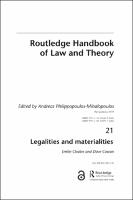Chapter 21 Legalities and materialities
Proposal review
| dc.contributor.author | Cloatre, Emilie | |
| dc.contributor.author | Cowan, Dave | |
| dc.date.accessioned | 2019-10-17 14:50:09 | |
| dc.date.accessioned | 2020-04-01T12:22:23Z | |
| dc.date.accessioned | 2018-09-27 23:55 | |
| dc.date.accessioned | 2019-10-17 14:50:09 | |
| dc.date.accessioned | 2020-04-01T12:22:23Z | |
| dc.date.available | 2020-04-01T12:22:23Z | |
| dc.date.issued | 2018 | |
| dc.identifier | 1001542 | |
| dc.identifier | OCN: 1076639537 | en_US |
| dc.identifier.uri | http://library.oapen.org/handle/20.500.12657/28415 | |
| dc.description.abstract | This chapter reflects on what materiality-inflected methodologies1 can bring to an anthropology of law, and to legal studies more generally. Its starting point is an increasing attention across the social sciences and humanities for objects, and thinking beyond the human. These have often, but not only, emerged from science and technology studies (STS), to which we pay particular attention. However, approaches to materiality have themselves become diversified, and their implications for law can similarly be read in multiple ways. At the same time, legal anthropology has helped to re-characterise the complexity of law as a field of social activity by paying attention to its meanings, for actors within as well as outside its own institutions; to its modes of action in practice, again within its explicitly designated spaces as well as its everyday; to its unexpected forms, patterns and directions; to its multiplicity and uncertainty. Approaches within a broadly defined ‘legal anthropology’ agenda have provided tools to move away from grand and removed theorisation of the law, or an exclusive attention to its own claims, and towards a subtler understanding of law as a relatively fluid, changing and uncertain set of practices. While doing so, legal anthropology has also reminded us of the significance of empirical research to identify and theorise the complex existences of law, a contribution which echoes some of the implications of materiality-oriented theories. | |
| dc.language | English | |
| dc.relation.ispartofseries | Routledge Handbooks | |
| dc.subject.classification | thema EDItEUR::J Society and Social Sciences::JH Sociology and anthropology::JHM Anthropology | en_US |
| dc.subject.classification | thema EDItEUR::L Law | en_US |
| dc.subject.other | law | |
| dc.subject.other | philosophy | |
| dc.subject.other | anthropology | |
| dc.subject.other | law | |
| dc.subject.other | philosophy | |
| dc.subject.other | anthropology | |
| dc.subject.other | Donna Haraway | |
| dc.subject.other | Ethnography | |
| dc.subject.other | Fractal | |
| dc.subject.other | Legal anthropology | |
| dc.subject.other | Legal consciousness | |
| dc.subject.other | Ontology | |
| dc.subject.other | Social theory | |
| dc.title | Chapter 21 Legalities and materialities | |
| dc.type | chapter | |
| oapen.relation.isPublishedBy | 7b3c7b10-5b1e-40b3-860e-c6dd5197f0bb | |
| oapen.relation.isPartOfBook | 1c7340d7-05ef-4751-8399-7c423f1fe4a6 | |
| oapen.relation.isbn | 9781317353003; 9781317352990; 9781317352983; 9781315665733 | |
| oapen.imprint | Routledge | |
| oapen.pages | 22 | |
| oapen.remark.public | Relevant Wikipedia pages: Anthropology - https://en.wikipedia.org/wiki/Anthropology; Donna Haraway - https://en.wikipedia.org/wiki/Donna_Haraway; Ethnography - https://en.wikipedia.org/wiki/Ethnography; Fractal - https://en.wikipedia.org/wiki/Fractal; Law - https://en.wikipedia.org/wiki/Law; Legal anthropology - https://en.wikipedia.org/wiki/Legal_anthropology; Legal consciousness - https://en.wikipedia.org/wiki/Legal_consciousness; Ontology - https://en.wikipedia.org/wiki/Ontology; Social theory - https://en.wikipedia.org/wiki/Social_theory | |
| oapen.remark.public | 3-8-2020 - No DOI registered in CrossRef for ISBN 9781138956469 | |
| oapen.identifier.ocn | 1076639537 | |
| peerreview.anonymity | Single-anonymised | |
| peerreview.id | bc80075c-96cc-4740-a9f3-a234bc2598f1 | |
| peerreview.open.review | No | |
| peerreview.publish.responsibility | Publisher | |
| peerreview.review.stage | Pre-publication | |
| peerreview.review.type | Proposal | |
| peerreview.reviewer.type | Internal editor | |
| peerreview.reviewer.type | External peer reviewer | |
| peerreview.title | Proposal review | |
| oapen.review.comments | Taylor & Francis open access titles are reviewed as a minimum at proposal stage by at least two external peer reviewers and an internal editor (additional reviews may be sought and additional content reviewed as required). |

